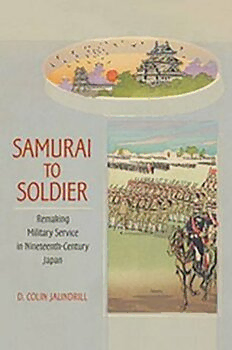
Samurai to Soldier: Remaking Military Service in Nineteenth-Century Japan PDF
Preview Samurai to Soldier: Remaking Military Service in Nineteenth-Century Japan
SAMURAI TO SOLDIER Studies of the Weatherhead East Asian Institute, Columbia University The Studies of the Weatherhead East Asian Institute of Columbia University were inaugurated in 1962 to bring to a wider public the results of significant new research on modern and contemporary East Asia. SAMURAI TO SOLDIER Remaking Military Service in Nineteenth-Century Japan D. Colin Jaundrill CORNELL UNIVERSITY PRESS ITHACA AND LONDON Copyright © 2016 by Cornell University All rights reserved. Except for brief quotations in a review, this book, or parts thereof, must not be reproduced in any form without permission in writing from the publisher. For information, address Cornell University Press, Sage House, 512 East State Street, Ithaca, New York 14850. First published 2016 by Cornell University Press Printed in the United States of America Library of Congress Cataloging-in-Publication Data Names: Jaundrill, D. Colin, 1980– author. Title: Samurai to soldier : remaking military service in nineteenth-century Japan / D. Colin Jaundrill. Description: Ithaca : Cornell University Press, 2016. | Series: Studies of the Weatherhead East Asian Institute, Columbia University | Includes bibliographical references and index. Identifiers: LCCN 2016006586 ISBN 9781501703096 (cloth : alk. paper) Subjects: LCSH: Japan—History, Military—19th century. | Draft—Japan— History—19th century. | Japan—Armed Forces—Recuiting, enlistment, etc.— History—19th century. | Samurai—History—19th century. Classification: LCC DS838.5 .J38 2016 | DDC 355.00952/09034—dc23 LC record available at http://lccn.loc.gov/2016006586 Cornell University Press strives to use environmentally responsible suppliers and materials to the fullest extent possible in the publishing of its books. Such materials include vegetable-based, low-VOC inks and acid-free papers that are recycled, totally chlorine-free, or partly composed of nonwood fibers. For further information, visit our website at www.cornellpress.cornell.edu. Cloth printing 10 9 8 7 6 5 4 3 2 1 Cover illustration: Unknown Japanese artist, Marching Soldiers and Castle, color lithograph, ink on card stock, n.d. (late Meiji era). 13.8 × 8.8 cm. Leonard A. Lauder Collection of Japanese Postcards, Museum of Fine Arts, Boston, 2002.5168. Photograph © 2016 Museum of Fine Arts, Boston. Cover design: Richanna Patrick For my wife Adeline and my daughter Grace, whose love and patience made the completion of this book possible. “So, then, the revolver triumphs over the sword; and this will probably make even the most childish axiomatician comprehend that force is no mere act of the will, but requires very real preliminary conditions before it can come into operation. . . .” —Friedrich Engels Contents List of Illustrations ix Acknowledgments xi Introduction 1 1. The Rise of “Western” Musketry, 1841–1860 13 2. Rising Tensions and Renewed Reform, 1860–1866 47 3. The Drives to Build a Federal Army, 1866–1872 73 4. Instituting Universal Military Service, 1873–1876 105 5. Dress Rehearsal: The Satsuma Rebellion, 1877 131 6. Organizational Reform and the Creation of the Serviceman, 1878–1894 156 Conclusion 178 Glossary 183 Notes 187 Bibliography 213 Index 223 vii Illustrations Map 1. Tokugawa and Meiji Japan: major domains (to 1871) and cities xiv Figures 1. An inspection of Takashima Shirōdayū’s musketry and gunnery training (1841) 24 2. Photograph of a Nirayama-gasa 28 3. Sugoroku board illustrating the steps and orders for musket and bayonet drill (late Tokugawa, probably Ansei, 1854–1860) 36 4 . Western-style [drill] twelve steps for loading (1868) 57 5. Utagawa Hiroshige II, M ishima , from the series Fifty-Three Stations of the Fan (1865) 76 6 . Utagawa Yoshifuji, M ilitary Drill of a Battalion (1867) 82 7. Sugoroku board illustrating drill for line and skirmishing (1866) 84 8 . Utagawa Yoshitora, The Great Military Review (1870) 89 9 . A first-time conscription class (1874) 117 10. Understanding Conscription Exemptions (1873) 126 11. Adachi Ginkō, News from Kagoshima: The Battle of Kumamoto Castle (1877) 134 12. Photograph of the topography around Tabaruzaka (1877) 140 13. The Barracks and Brigade Headquarters at Sakura (1889) 172 14. Shunsai Toshimasa, T rue Illustration of the Grand Maneuvers at Nagoya in Owari, Attended by the Emperor (1890) 175 Table 1 . Conscription and exemption statistics from 1873 to 1886 165 ix
